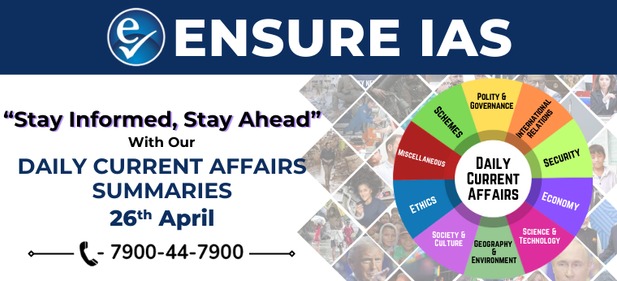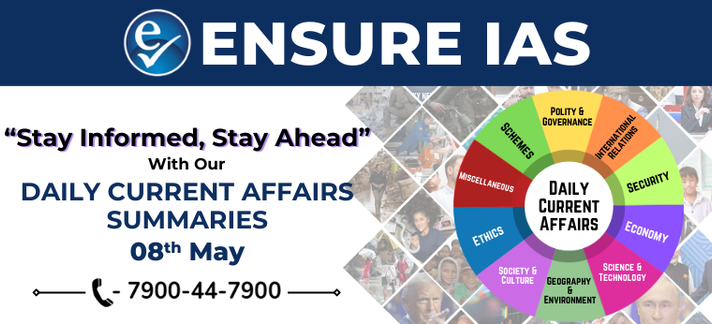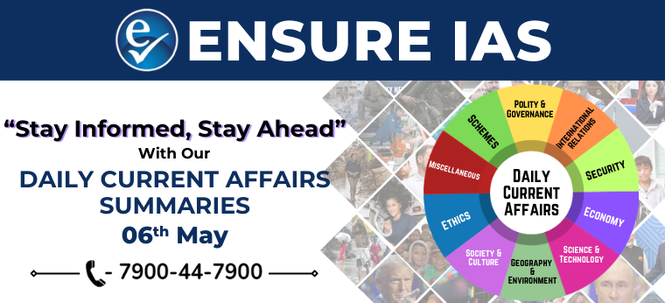- Courses
- GS Full Course 1 Year
- GS Full Course 2 Year
- GS Full Course 3 Year
- GS Full Course Till Selection
- Answer Alpha: Mains 2025 Mentorship
- MEP (Mains Enrichment Programme) Data, Facts
- Essay Target – 150+ Marks
- Online Program
- GS Recorded Course
- Polity
- Geography
- Economy
- Ancient, Medieval and Art & Culture AMAC
- Modern India, Post Independence & World History
- Environment
- Governance
- Science & Technology
- International Relations and Internal Security
- Disaster Management
- Ethics
- Current Affairs
- Indian Society and Social Issue
- NCERT- Science and Technology
- NCERT - Geography
- NCERT - Ancient History
- NCERT- World History
- CSAT
- 5 LAYERED ARJUNA Mentorship
- Public Administration Optional
- ABOUT US
- OUR TOPPERS
- TEST SERIES
- FREE STUDY MATERIAL
- VIDEOS
- CONTACT US
Daily Current Affairs Summary 26th APRIL 2025
Daily Current Affairs Summary 26th APRIL 2025

UN Warns of Rising Global Social Crisis: World Social Report 2025
- The World Social Report is the flagship publication of the United Nations Department of Economic and Social Affairs (UN DESA).
- It addresses emerging global social development challenges and guides policy directions for inclusive progress.
- The 2025 Report highlights rising insecurity, inequality, and distrust as key threats to social cohesion.
What Vision Does the Report Propose?
- The report urges a new global policy consensus anchored in three core principles:
▪️ Equity,
▪️ Economic security for all,
▪️ Solidarity. - It advocates for people-centered policymaking that aligns with past global commitments on social development.
|
What is the Copenhagen Declaration on Social Development (1995)?
|
What Were the Key Commitments of the Declaration?
- Eradication of Poverty:
▪️ Recognized poverty elimination as both an ethical duty and a social necessity. - Full Employment:
▪️ Promoted productive and full employment as a primary development goal. - Social Integration:
▪️ Emphasized the need for inclusive societies that integrate all individuals equitably.
What Are the Key Issues Highlighted in the 2025 Report?
- Insecure Livelihoods and Persistent Poverty Risks:
▪️ Over 690 million people live in extreme poverty globally.
▪️ An additional 2.8 billion are near the poverty line, vulnerable to small economic shocks.
▪️ Poverty escapes remain fragile and easily reversible. - Rising and Entrenched Inequalities:
▪️ Income inequality has increased in 52 of 128 countries over the past three decades.
▪️ Countries with growing inequality include China, India, and most high-income nations.
▪️ The widening gap, measured via the Gini coefficient, reflects deep structural divides. - Declining Trust and Weakening Social Cohesion:
▪️ Global trust in governments and institutions is on the decline.
▪️ Around 57% of people worldwide report low confidence in their government.
▪️ This erosion of trust threatens democratic governance and social harmony.
What Solutions Does the Report Recommend?
- Integrate a Social Perspective in Policymaking:
▪️ Inspired by the Copenhagen Declaration, policies must prioritize human wellbeing. - Promote Human Development:
▪️ Governments should invest in quality public services—education, healthcare, housing.
▪️ Establish universal and adequate social protection systems to cushion vulnerabilities. - Strengthen Institutions for Social Cohesion:
▪️ Build institutions that are trustworthy, inclusive, and flexible.
▪️ Promote equity and fairness through transparent and responsive governance.
Mati Carbon Wins $50M XPRIZE for Scalable Carbon Removal Innovation
- Mati Carbon, an Indian-led climate startup, has won the $50 million XPRIZE Carbon Removal competition.
- The innovation utilizes a method called Enhanced Rock Weathering (ERW) to capture atmospheric carbon dioxide (CO₂).
- This approach also benefits smallholder farmers by improving crop yields, merging climate action with social impact.

How Enhanced Rock Weathering Works
What is the XPRIZE Carbon Removal Challenge?
- The XPRIZE Carbon Removal was launched in 2021 to accelerate breakthroughs in scalable CO₂ removal technologies.
- The challenge incentivizes innovative, durable, and measurable solutions that can help stabilize Earth’s climate.
What is Enhanced Rock Weathering (ERW)?
- Enhanced Rock Weathering involves crushing volcanic rocks like basalt or olivine into fine powder.
- This mineral powder is spread over farmlands, forests, and coastal areas to enhance natural carbon absorption.
- Once applied, the minerals chemically react with atmospheric CO₂, converting it into stable, inorganic carbon forms.
- These stable compounds wash into rivers, lakes, and oceans, locking away carbon for thousands of years.
- Basalt is especially effective due to its high calcium, magnesium, and iron content, which boost CO₂ absorption.
How Does ERW Benefit Agriculture?
- The basalt powder improves soil health, leading to higher crop productivity.
- Farmers using this technique report up to 70% increase in crop yields, especially in nutrient-depleted soils.
- As basalt releases natural minerals, it reduces the need for chemical inputs.
- Fertiliser expenses are lowered and pesticide usage drops by 65%, making it more sustainable.
What Environmental Advantages Does ERW Offer?
- ERW contributes to ocean health by increasing alkalinity of seawater, helping mitigate ocean acidification.
- The captured carbon is stored in inorganic form for over 10,000 years, far exceeding organic sequestration methods.
- This ensures long-term climate impact with minimal risk of carbon re-release.
Why is ERW Scalable and Practical?
- Basalt and other volcanic rocks are abundant across the globe, making feedstock supply non-limiting.
- ERW leverages existing mining and transportation infrastructure, reducing setup costs.
- The process uses readily available agricultural equipment, making it low-tech and easy to adopt.
- These factors make ERW a cost-effective, scalable, and field-ready solution for carbon removal.
BRIC-inStem
- India has achieved a major scientific breakthrough in gene therapy for Haemophilia.
- The research was conducted at BRIC-inStem, a leading institute for stem cell science and regenerative medicine.
What is Haemophilia?
- Haemophilia is a genetic bleeding disorder where blood fails to clot normally.
- It is inherited and can lead to prolonged bleeding even from minor injuries.
- Patients require lifelong treatment, making gene therapy a promising curative option.
What is BRIC-inStem?
- inStem refers to the Institute for Stem Cell Science and Regenerative Medicine based in Bangalore, India.
- It is a state-of-the-art research center specializing in stem cell and regenerative biology.
- inStem operates under the umbrella of BRIC – Biotechnology Research and Innovation Council.
What is BRIC?
- BRIC was established in 2023 to consolidate India’s biotechnology research ecosystem.
- It brought together 14 autonomous biotechnology institutions under one integrated platform.
- BRIC aims to streamline governance, accelerate innovation, and enable interdisciplinary collaboration.
Significance of the Breakthrough
- The gene therapy success marks a milestone for Indian biomedical research.
- It paves the way for affordable, indigenous treatment solutions for genetic disorders.
- This achievement places India on the global map for advanced gene-based therapies.
ILO Flags Job Quality Concerns Due to Algorithmic Management
- A recent International Labour Organization (ILO) report highlights the growing concerns over declining job quality due to algorithmic management practices.
- The trend raises questions about workers’ autonomy, transparency, and fairness in digitally managed work environments.
What is Algorithmic Management (AM)?
- Algorithmic Management refers to the use of digital systems to allocate, monitor, and evaluate work tasks and worker performance.
- It relies heavily on real-time data collection, surveillance tools, and performance metrics to govern workplace operations.
- AM essentially automates tasks that were traditionally performed by human supervisors or managers.
What Technologies Enable Algorithmic Management?
- AM systems integrate big data analytics, machine learning algorithms, geolocation services, and wearable devices.
- These technologies allow employers to track workers’ actions, movements, productivity, and efficiency in real time.
- Decision-making becomes automated or AI-supported, reducing the role of direct human oversight.
Where is Algorithmic Management Being Adopted?
- While once limited to digital platforms, AM has now expanded into traditional industries.
- It is increasingly used in warehouses, manufacturing units, transportation services, call centres, and logistics.
- This signals a shift towards digitally managed labor systems even in physical, non-platform-based workplaces.
Why is ILO Concerned?
- The ILO warns that excessive reliance on AM may undermine job quality, privacy, and worker well-being.
- Workers often lack transparency on how decisions are made and how their data is used.
- Algorithmic oversight can lead to high pressure, limited human interaction, and inflexible work conditions.
India Launches National Campaign to Eliminate Measles and Rubella by 2026
- The Ministry of Health and Family Welfare has launched the National Zero Measles-Rubella Elimination Campaign.
- This initiative was unveiled during World Immunization Week, reinforcing India’s commitment to disease prevention.
What are Measles and Rubella?
- Measles and Rubella are highly contagious viral infections that can lead to severe health complications or death.
- These diseases are especially dangerous for children and pregnant women, often causing lifelong disabilities.
India’s Elimination Target
- India has set a national goal to eliminate Measles and Rubella by the year 2026.
- The campaign is a major step under the Universal Immunization Programme (UIP).
MR Vaccine Coverage in India
- Under UIP, two doses of the Measles-Rubella (MR) vaccine are provided free of cost to children.
- As per 2024–25 Health Management Information System (HMIS) data:
- First-dose coverage of MR vaccine stands at 93.7%.
- Second-dose coverage has reached 92.2%, indicating strong immunization progress.
India Restricts Pakistan from SAARC Visa Exemption Scheme
- The Government of India has officially announced that Pakistan nationals will no longer be allowed to travel to India under the SAARC Visa Exemption Scheme (SVES).
- This move marks a significant policy shift in regional visa cooperation, reflecting broader geopolitical tensions.
What is the SAARC Visa Exemption Scheme (SVES)?
- The SAARC Visa Exemption Scheme was launched in 1992, following the decision made during the 4th SAARC Summit held in Islamabad in 1988.
- The primary aim of SVES is to strengthen people-to-people ties and boost regional cooperation among SAARC member states.
Who is Eligible Under the Scheme?
- Currently, the scheme covers 24 categories of entitled individuals for visa-free travel among SAARC nations.
- These categories include Heads of State, Parliamentarians, Judges of higher courts, Senior Government Officials, and other dignitaries.=
What is SAARC?
- The South Asian Association for Regional Cooperation (SAARC) was established with the adoption of its Charter in Dhaka in 1985.
- SAARC was formed to promote regional integration, peace, and economic development among South Asian nations.
- The current members of SAARC include Afghanistan, Bangladesh, Bhutan, India, Maldives, Nepal, Pakistan, and Sri Lanka.
Toxic Metal Pollution in Soil: A Global Concern
- A study reveals that 242 million hectares of global cropland, or 16%, is impacted by toxic metal pollution.
- Key regions most at risk include southern China, northern and central India, and the Middle East.
- Soil pollution from toxic metals poses significant risks to food production and food safety.
Types of Toxic Metals in Soil
- Heavy metals and metalloids are non-degradable, accumulating over decades in the soil.
- Key pollutants: Arsenic (As), Cadmium (Cd), Chromium (Cr), Mercury (Hg), Lead (Pb), Copper (Cu), Zinc (Zn), and Nickel (Ni).
- Cadmium is the most widespread toxic metal, exceeding safe levels in 9% of soils worldwide.
Sources of Toxic Metals in Soil
- Geogenic Sources:
- Derived from bedrocks (soil parent materials).
- Emissions from volcanic activity and wind erosion also contribute.
- Anthropogenic Sources:
- Agricultural activities (e.g., irrigation, fertilizers).
- Household sources (e.g., paints, batteries).
- Industrial activities (e.g., mining, metal smelting).
Consequences of Soil Pollution by Toxic Metals
- Ecosystem Disruption:
- Soil pollution affects the primary productivity of both natural and agricultural ecosystems.
- Leads to the loss of soil ecosystem services (refer infographic).
- Human Health: Exposure to soil pollution results in over 500,000 premature deaths globally each year.
- Bioaccumulation: Toxic metals accumulate in organisms, potentially entering the human food chain and rendering them hazardous.
- Nutrient Imbalance: Pollution alters soil biodiversity and disrupts nutrient cycles, leading to nutrient imbalance.
CCS Responds to Security Situation in Pahalgam
- The Cabinet Committee on Security (CCS) has taken key decisions in response to the recent developments concerning Pakistan’s actions in Pahalgam.
- This reflects India’s strategic focus on safeguarding national security and territorial integrity.
What is the Cabinet Committee on Security (CCS)?
- The CCS is the highest decision-making body on matters of national security and defence.
- It is chaired by the Prime Minister of India and includes four key ministers:
- Minister of Finance
- Minister of Defence
- Minister of Home Affairs
- Minister of External Affairs
- Chiefs of Defence Services and senior bureaucrats may also be invited when required, especially for defence-related deliberations.
Core Functions of CCS
- The CCS formulates national security strategies and supervises matters of defence preparedness.
- It decides on key security-related appointments and deals with law and order issues of national importance.
- The committee also addresses internal security challenges, strategic foreign policy decisions, and counter-terrorism measures.
|
Cabinet Committees
|
Musk Deer Conservation: CZA Highlights Inaction in Indian Zoos
- A recent report by the Central Zoo Authority (CZA) confirms that no breeding programme has been initiated in Indian zoos for the conservation of musk deer.
- This raises concerns for a species already under significant poaching pressure and facing habitat threats.
What Are Musk Deer?
- Musk deer are small, solitary hoofed mammals (ungulates), active mainly during night or twilight hours.
- They belong to the family Moschidae and are known for their shy and elusive nature.
- The group consists of 7 recognized species, such as the Kashmir musk deer, Himalayan musk deer, and Anhui musk deer.
- These species are found across 13 Asian countries, including India, Nepal, Bhutan, Pakistan, China, Myanmar, and Russia (Siberia).
Why Are They Hunted?
- Adult male musk deer possess a musk gland, which secretes a substance used to attract mates during the breeding season.
- This musk secretion is highly valued in the perfume industry, making the species vulnerable to illegal hunting and poaching.
Where Are Musk Deer Found in India?
- Key habitats in India include the Askot Wildlife Sanctuary (Uttarakhand) and Gangotri National Park.
- These areas provide the cold, forested environments needed for the species' survival.
Conservation Status of Musk Deer
- As per the IUCN Red List, most musk deer species are classified as Endangered, except the Siberian musk deer, which is listed as Vulnerable.
- Under CITES (Convention on International Trade in Endangered Species):
- Populations from Afghanistan, Bhutan, India, Myanmar, Nepal, and Pakistan are listed in Appendix I (highest protection).
- All other populations are included in Appendix II.
- In India, the species is protected under Schedule I of the Wildlife (Protection) Act, 1972, offering the highest level of legal safeguard.
Sports Certificates Now on DigiLocker
- The Union Minister for Youth Affairs & Sports and Labour & Employment launched the digital issuance of sports certificates through DigiLocker.
- The launch event took place at the Indira Gandhi Stadium in New Delhi.
- These certificates will soon be integrated with the National Sports Repository System (NSRS).
- This integration will enable automatic disbursal of government cash rewards directly into athletes’ bank accounts, ensuring transparency and timely recognition.
What is DigiLocker?
- DigiLocker is a secure, cloud-based platform that provides access to authentic digital documents.
- It was launched in 2015 as a key initiative under the Digital India programme.
- The platform is developed and maintained by the Ministry of Electronics and Information Technology (MeitY).
- Its core objective is to promote ‘Digital Empowerment’ by enabling citizens to access documents anytime, anywhere through their digital document wallet.
Key Features & Benefits of DigiLocker
- Eliminates physical document handling, reducing paper usage and manual verification delays.
- Offers real-time access to certificates issued by government departments and institutions.
- Helps establish a trusted ecosystem where documents can be shared instantly with authorities and service providers.
- Sports certificates via DigiLocker will ensure easy verification, faster recognition, and direct benefit transfers to eligible athletes.
AI Kiran: Empowering Women in the Age of Artificial Intelligence
- AI Kiran is a new initiative aimed at empowering women in the field of Artificial Intelligence.
- It aspires to build a vibrant AI ecosystem where women actively contribute as innovators, changemakers, and leaders.
- The initiative is spearheaded by the Office of the Principal Scientific Adviser (PSA) to the Government of India.
- It aims to recognize and amplify the contributions of over 250 women professionals advancing AI across key sectors.
- Major focus areas include education, healthcare, and other critical domains where AI is making transformative impact.
What is the KIRAN Scheme?
- KIRAN stands for Knowledge Involvement in Research Advancement through Nurturing.
- It is an umbrella scheme launched by the Department of Science and Technology (DST).
- The primary goal is to promote gender parity by encouraging and supporting women in science and technology.
- The scheme nurtures women's scientific talent through various fellowships, grants, and career advancement opportunities.
Connecting AI Kiran with the KIRAN Scheme
- While KIRAN supports women's entry and growth in STEM fields, AI Kiran brings focused attention to AI and emerging technologies.
- Together, they aim to create a gender-inclusive innovation landscape aligned with India’s Digital and AI strategy.
- The initiatives represent a coordinated effort to leverage talent diversity in shaping the country’s tech-driven future.
|
Also Read |
|
| FREE NIOS Books | |




